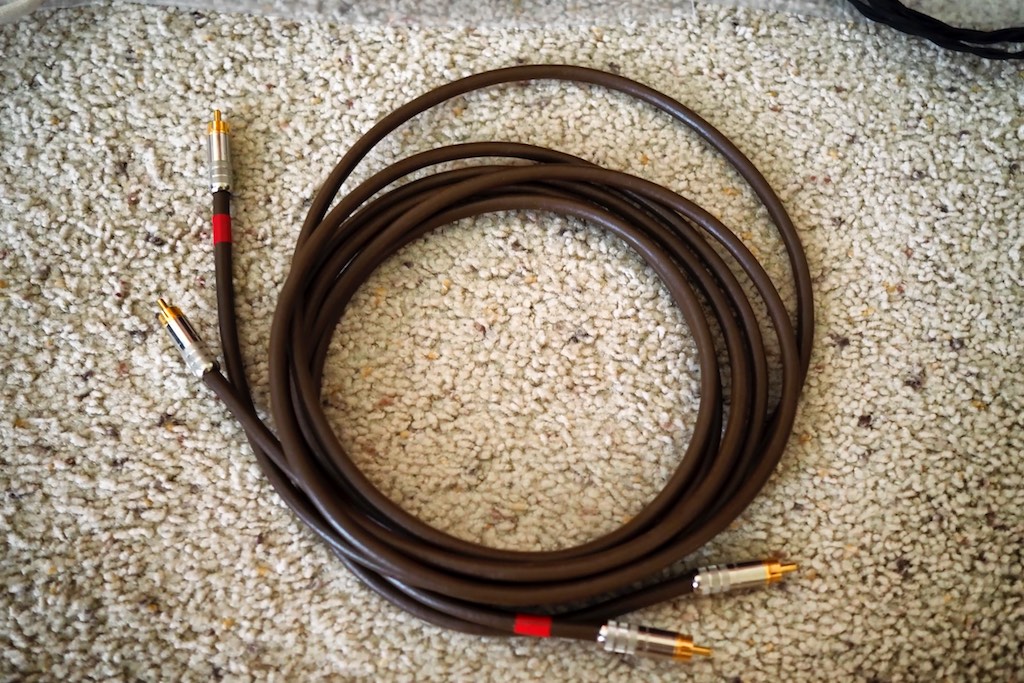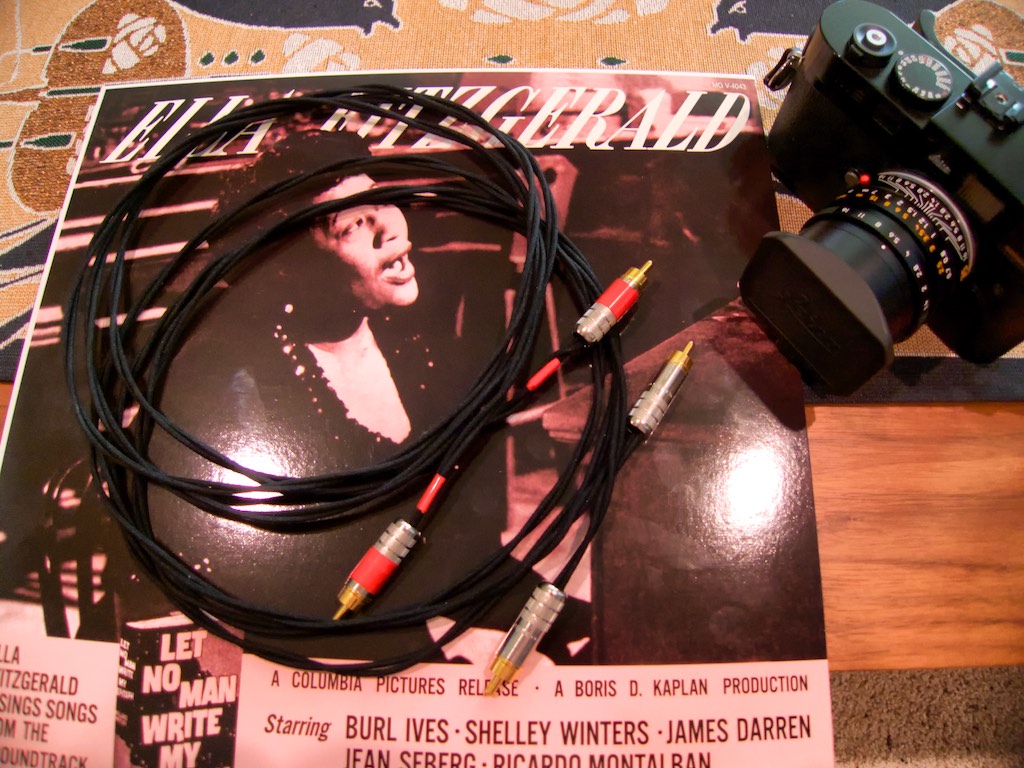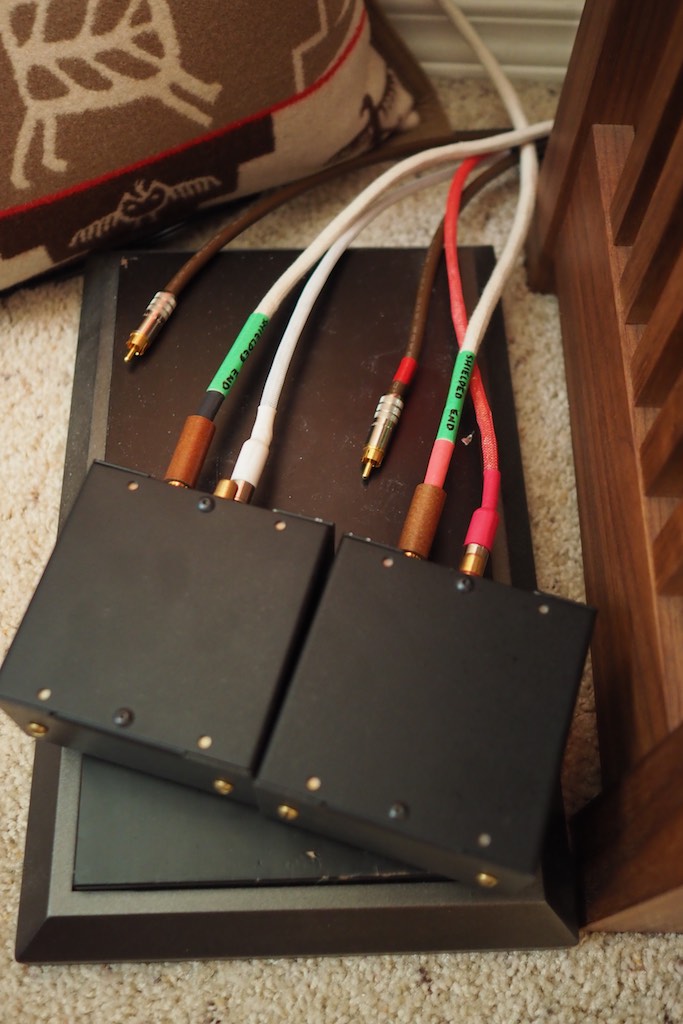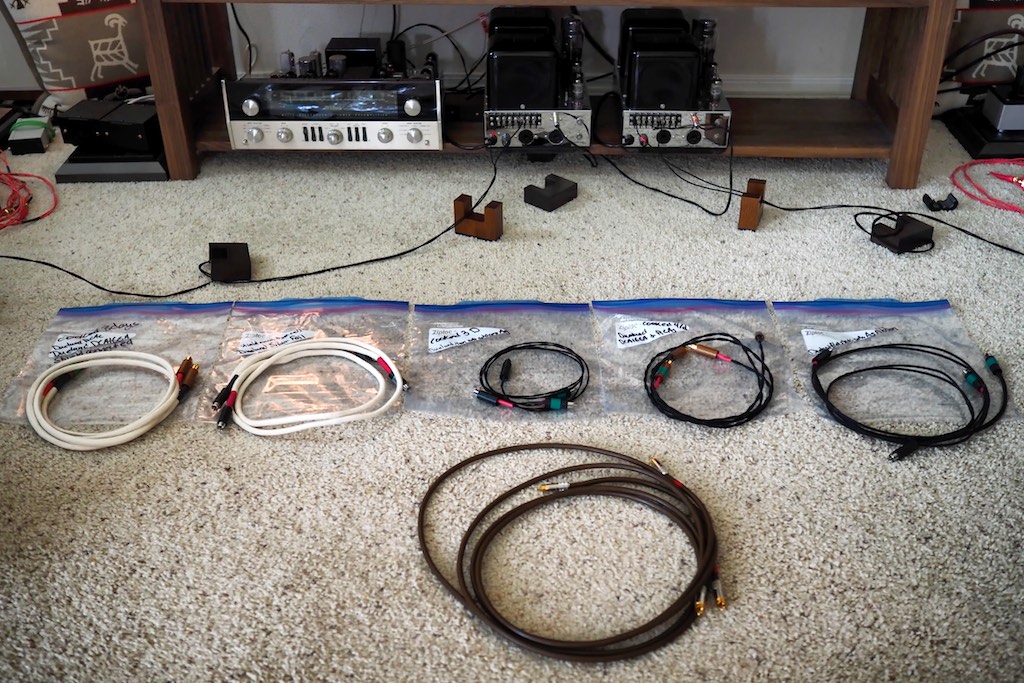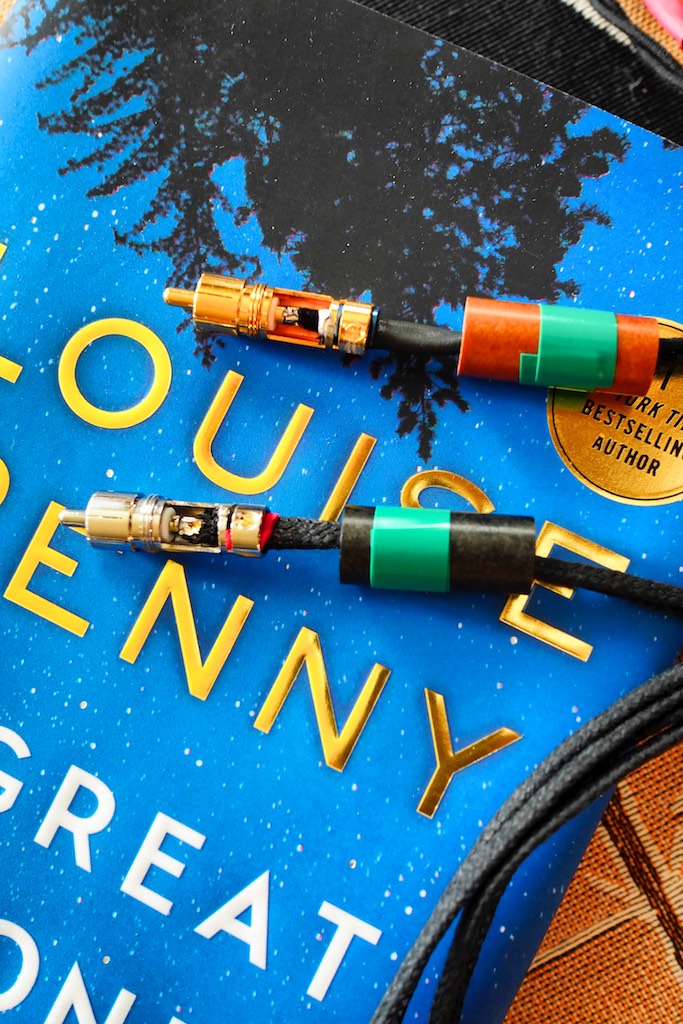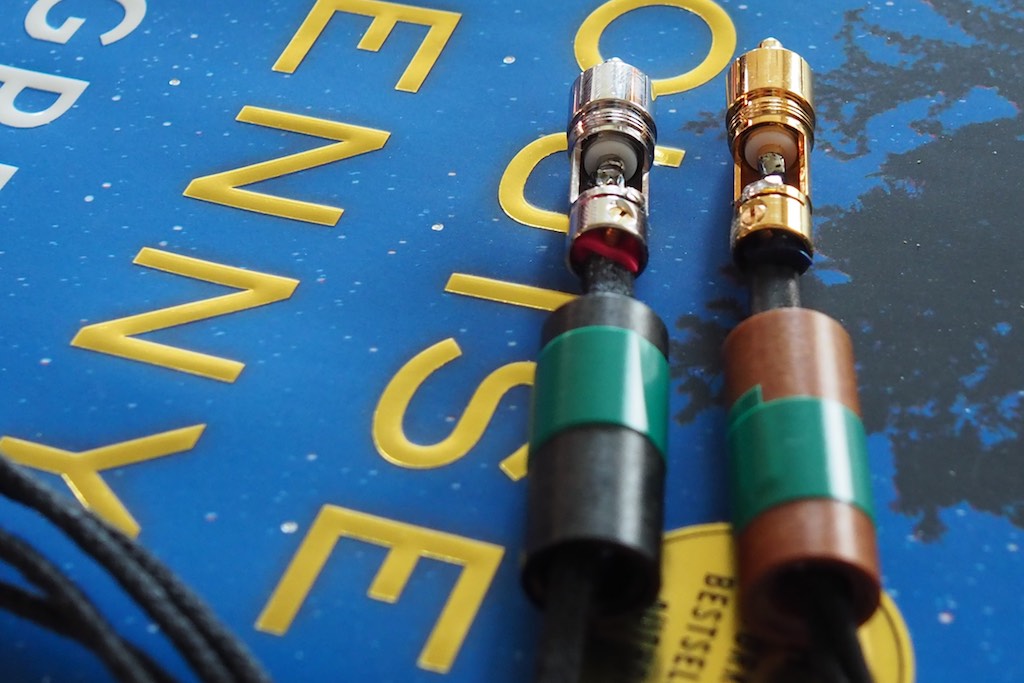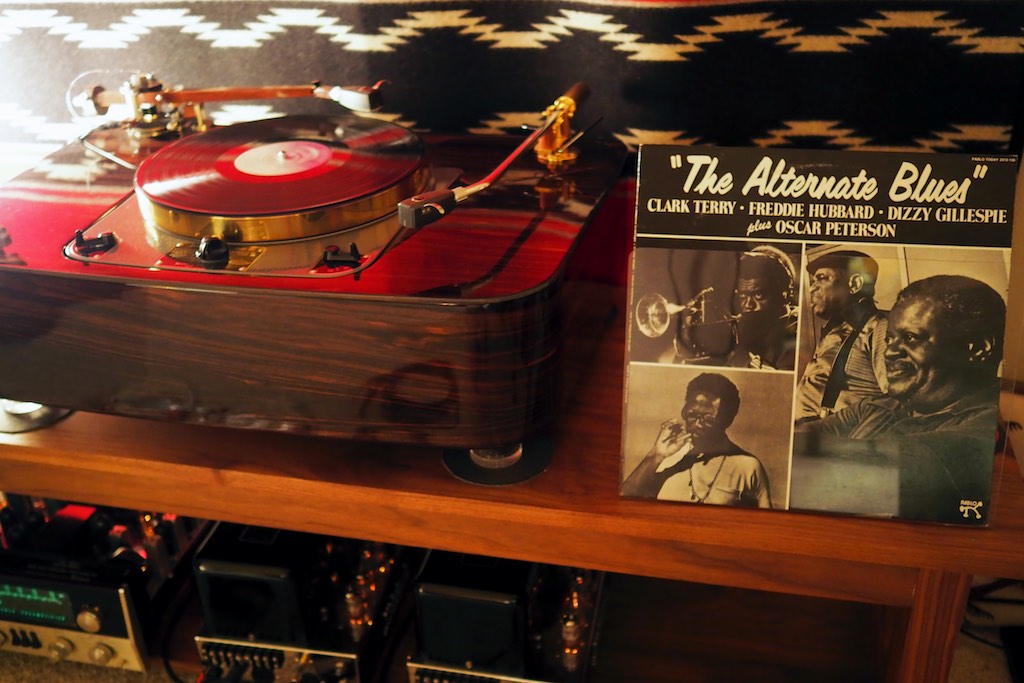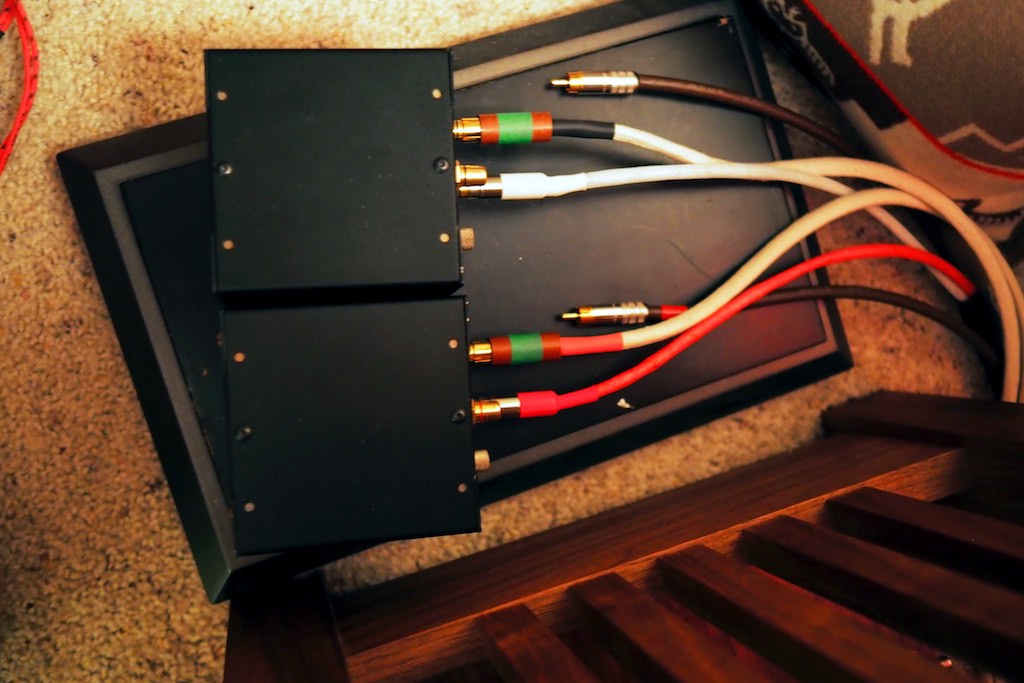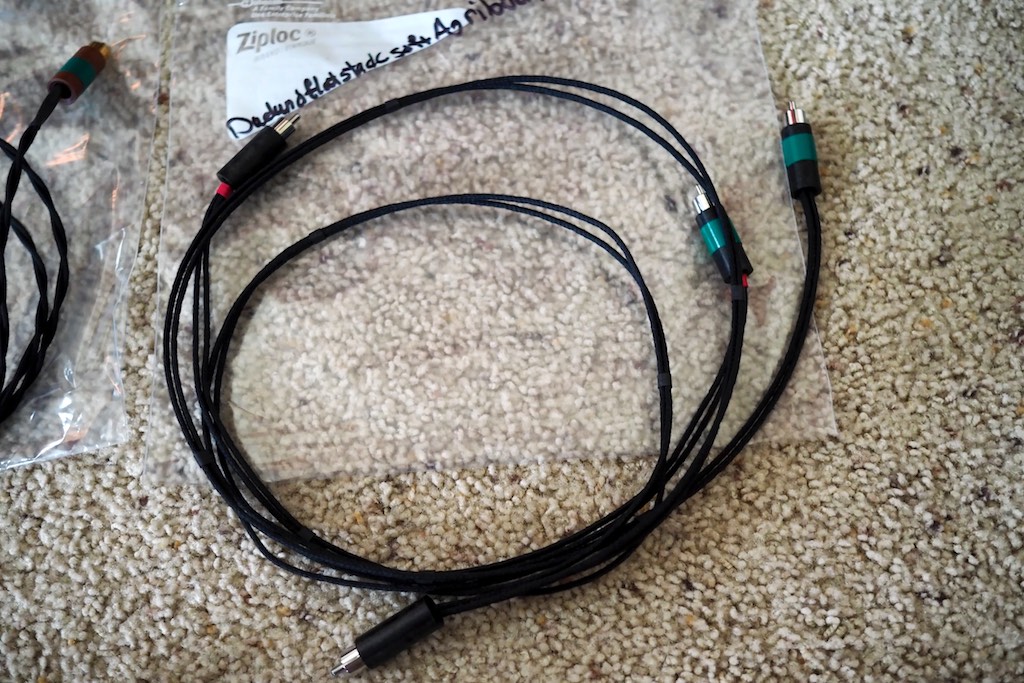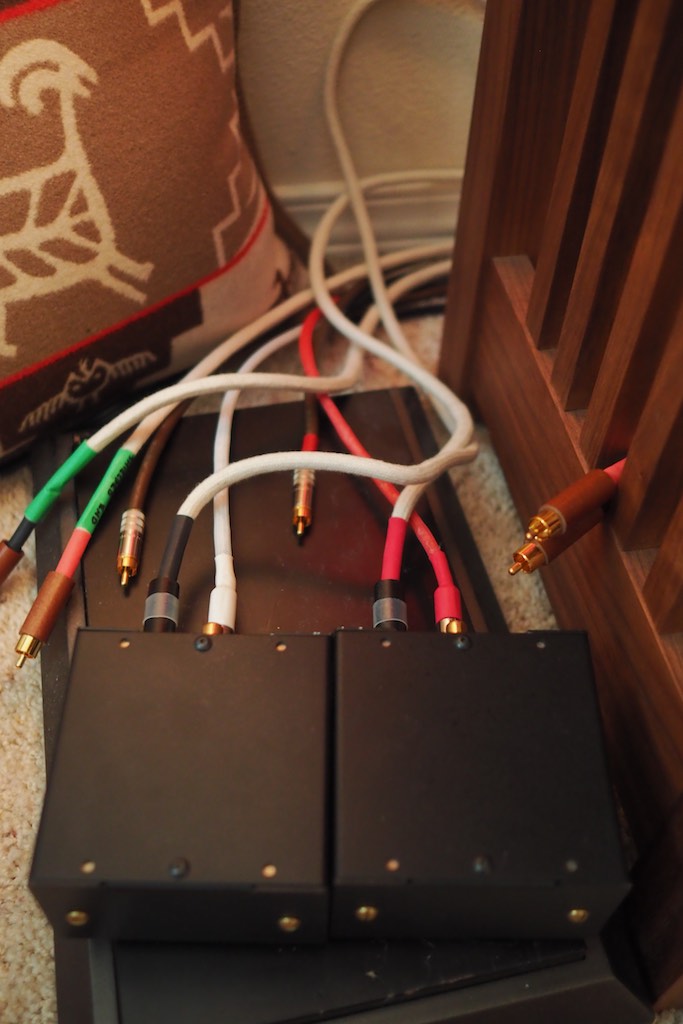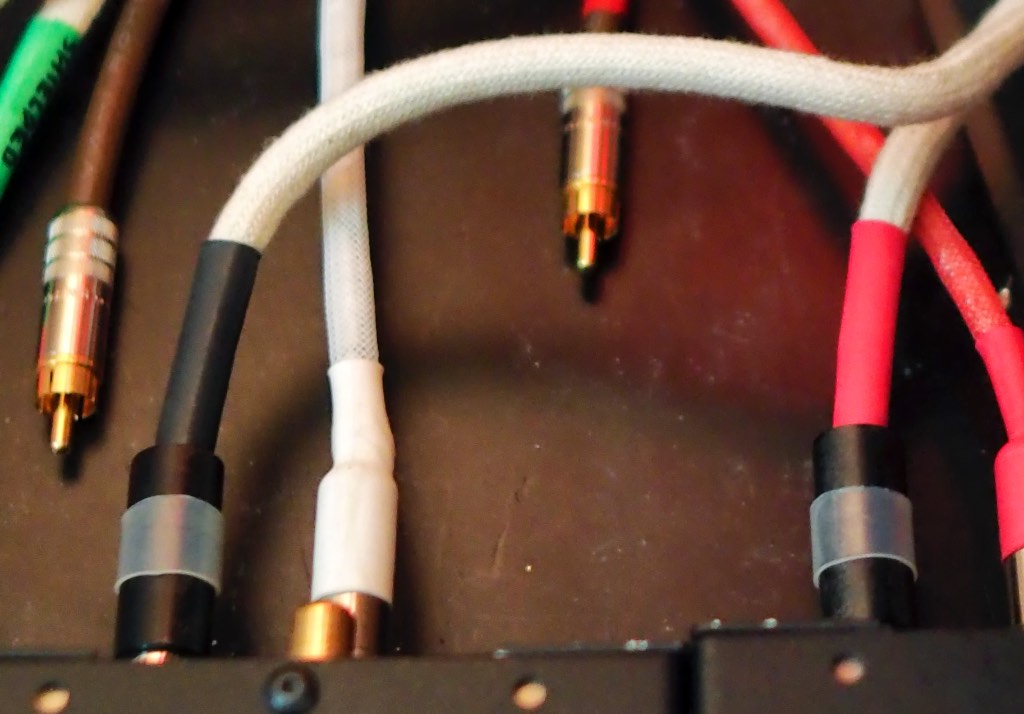I really appreciate Yazaki-san introducing me to the 'real sound' of the vintage Western Electric WE16GA wire as speaker cables, and the Belden 8402 microphone cable as interconnects, as they completely changed the way I think about audio cabling.
What do they have in common? Tinned-copper conductors!
Their unfailing musicality, realistic timbral textures, vivid tone color, and ability to emotionally connect me to the music were unparalleled in my experience.
If you've been following my reporting here at Jeff's Place over the last year or so, you know I was getting panicky about the unavailability of the wonderful vintage Western Electric WE16GA wire that I'd been writing about.
Unfortunately, my writing about it made it popular beyond all imagination, and it basically went extinct. To my great dismay, I received reports of unethical sellers who began selling fake Western Electric WE16GA in an attempt to profit off its popularity after the real thing was no longer available!
To my great delight, Frederik Carøe of Duelund Coherent Audio also became intrigued with the vintage Western Electric WE16GA, and with a little help of reverse engineering from yours truly, Frederik created a modern version of it.
Frederik even went the ol' Western Electric one better by using an oil soaked & baked cotton insulator over the tinned-copper conductors, instead of the plastic & fabric insulator of the Western Electric.
As you know from my blog posts, I've been very impressed with the performance of the Duelund DCA16GA wire as speaker cables on my vintage Altec A5 Voice of the Theatre loudspeakers, as well as on my Harbeth Super HL5 loudspeakers, and now as interconnects with my vintage McIntosh MX110Z tuner preamplifier and MC30 monaural amplifiers.
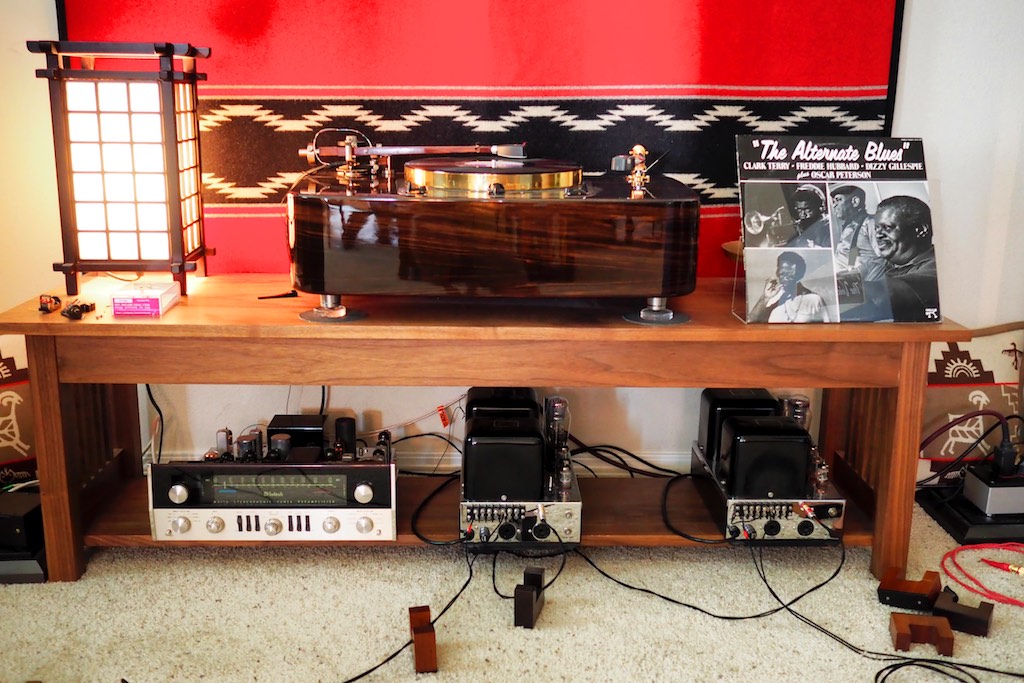
Vintage McIntosh MX110Z tuner-preamplifier and MC30 monaural amplifiers with Duelund DCA16GA as speaker cables and interconnects.
My foray into using the Duelund DCA16GA as DIY interconnects has impressed me mightily.
First I built a pair of 2-meter DCA16GA interconnects with Switchcraft RCA's to go from my vintage McIntosh MX110Z tuner-preamplifier to my MC30 monaural amplifiers, and the result dethroned my beloved Belden 8402 microphone cable interconnects.
Then I made up a pair of 1-meter Duelund DCA16GA interconnects to use from my dual mono Intact Audio custom SUTs (that I use for my Ortofon SPU Classic GM MkII) to my MX110Z.
That experiment was a flop, as the unshielded Duelund DCA16GA interconnects were just too noisy in that position with the SUT, so the the shielded Belden 8402 microphone cables that I'd been using in that position went back in.
Then in a wonderful bit of serendipity, Chris at Parts ConneXion offered to make up some shielded Duelund DCA16GA interconnects for me to try (thank you, Chris!), as well as a number of other Duelund interconnects using various kinds of exotic Duelund wire (soft annealed silver ribbon, soft annealed solid-core silver, as well as DCA16GA variations), all using the beautiful Duelund RCA's.
As I reported a couple of blog posts ago, after I conditioned the shielded (shield connected to ground at source end) Duelund DCA16GA interconnects that Chris made, for a couple of days on my audiodharma Cable Cooker, they sounded fantastically musical, and they've now displaced my Belden 8402 microphone cable interconnects in that position.
I wanted to give you a couple of close-up photos of the Duelund RCA's. The photos don't really do them justice, they're beautifully made in the Duelund tradition.
The Duelund RCA'a are available as rhodium or gold over OCC copper, and they use a natural fiber (compressed paper) outer shell like the outer form of the Duelund CAST capacitors, natural for the gold, and black for the rhodium. I find the gold with the natural outer shell to be particularly beautiful, although the rhodium/black combination is very attractive too.
I use the green microphone cable tape to mark the source end so I don't mix them up directionally.
Ok, well there's an intro for you, and I'll be back shortly with some more listening impressions!
***
I listened to a couple of albums with the shielded Duelund DCA16GA interconnects (with the shield connected at source end) to establish a baseline, then I got out the shielded Duelund DCA16GA interconnects with the shield connected at both ends in Yazaki-san fashion.
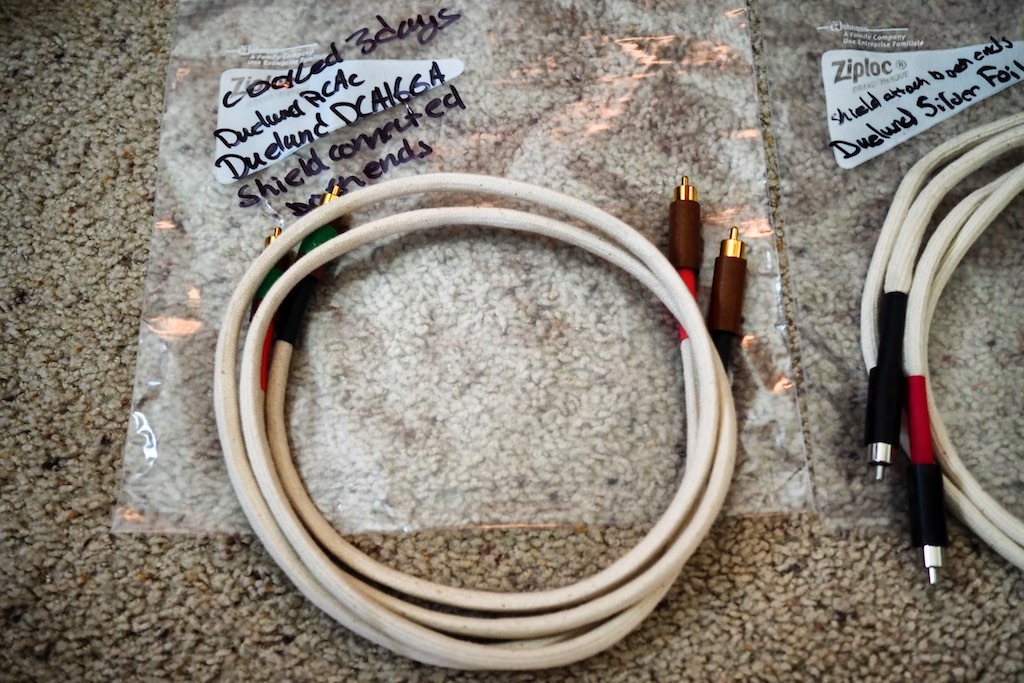
Shielded Duelund DCA16GA interconnects in Yazaki-san style with the shield connected to ground at both ends.
On The Alternate Blues, my go-to horn album of late, the shielded Duelund DCA interconnects (source end of the shield grounded) were very quiet on my dual mono Intact Audio custom SUTs, and startlingly dynamic.
The trumpet timbre The Alternate Blues was rendered about as perfectly as you could ask for, and the cymbals on Bobby Durham's drums sounded as natural as I've ever heard them. Joe Pass' guitar was sublime, Ray Brown's bass was viscerally present, and Dizzy Gillespie's, Clark Terry's, and Freddie Hubbard's trumpet and/or Flugelhorn were about as realistic as you could ask for. Fantastically real timbre, vivid tone color, dramatic dynamics, and a musical intensity that's really impressive.
The soundstage was expansive and deeply layered front to back, the sense of space was dramatic in fill-the-room fashion, and the imaging was viscerally solid in a natural sort of way. The resolution was perfect, being resolving to a natural level, without ever being analytical or overdone.
With the second pair of shielded Duelund DCA16GA interconnects that Chris made up for comparison, shielded in Yazaki-san fashion (shield grounded at both ends), but otherwise identical to the pair with the shield connected at the source end only, I thought they sounded very slighly noisier on the SUTs with no music playing, but still very quiet, with the slight additional noise completely inaudible with music playing. I almost forgot to say I conditioned them on the Cable Cooker for 3 days, which I've found to be important with the shielded interconnects, otherwise than can sound a bit rough and forward until they run-in.
I found the dynamics of the second pair of shielded Duelund DCA16GA interconnects (above) to be as dramatic & satisfying as I did with the first pair (shielded at the source end only), but overall I thought the first pair to be more realistic timbrally and in the presentation of tone color. But it was very close between the two, and the second pair deserves more playing time, so I can be sure of the outcome.
Interestingly, with the ground connected at both ends in Yazaki-san fashion, the trumpets sounded more forward, which is the exact opposite of with the Belden 8402's, which sounded warmer and richer with the shield connected at both ends, than when connected only at the source end. Go figure.
At this point I would rank the combination of sonics & musicality of the shielded Duelund DCA16GA (shield grounded at the source end only) as occupying the top step of the podium, with the Belden 8402 microphone cable interconnect (with shield grounded at both ends) coming in second, and the shielded Duelund DCA16GA (shield grounded at both ends) coming in third.
But there's a caveat: The shielded Duelund DCA16GA with the shield grounded at both ends only had three days of conditioning on the Cable Cooker, versus the four days of conditioning with the shielded Duelund DCA16GA that was grounded only at the source end. I think I'll put them back on the Cable Cooker for an additional day to even the playing field, then try them again.
Sunday, October 9th:
While the shielded Duelund DCA16GA that was built Yazaki-san style was getting a little extra conditioning time on the Cable Cooker, I decided I wanted to give the shielded Duelund soft annealed silver foil interconnect that Chris made up a try on the SUT (constructed Yazaki-san style with shield grounded at both ends).
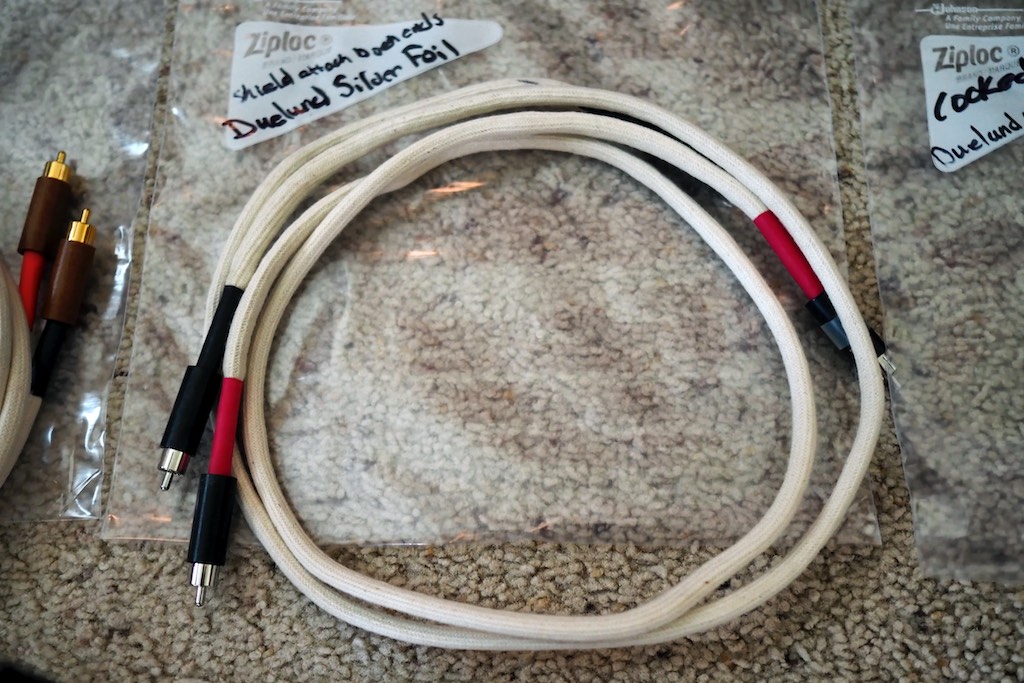
Duelund Shielded Soft Annealed Silver Foil Interconnect constructed Yazaki-san style with shield grounded at both ends.
When Leo, Pete, Ron, and Santos were over visiting last Sunday we tried the unshielded version of the Duelund soft annealed silver foil interconnect that Chris made on MX110Z to MC30 monaural amplifiers connections, but we thought it was a little too laid back for the current voicing of my Altec A5 crossovers.
The Duelund soft-annealed silver foil interconnects sounded rich, smooth, and warm, which is something you don't normally associate with silver conductors, and are traits that I normally like a lot, but it wasn't the best match to the Altec A5 Voice of the Theatre loudspeakers.
I should also mention that was without any conditioning time on the Cable Cooker, which you probably wouldn't want to do with the Duelund soft-annealed silver foil interconnects, as they already sound smooth and laid back.
I have a hunch that the Duelund soft-annealed silver foil interconnects might be a match made in heaven for my Tannoy Westminster Royal SE loudspeakers, which are more forward, detailed, and aggressive in the mid-range than the Altec's, and could use a little of that rich, smooth, and warm tender-loving-care from the Duelund soft-annealed silver foil interconnects. I'll be really looking forward to giving that a try!
After giving The Alternate Blues another listen with the shielded Duelund DCA16GA (shield grounded at source end) on the SUT this morning to reestablish a listening baseline, I shut the system down and replaced them with the shielded Duelund soft annealed silver foil interconnects (shield grounded at both ends).
On the SUT the shielded Duelund soft annealed silver foil interconnects didn't sound as rich, smooth, and warm as the unshielded Duelund soft annealed silver foil interconnects did on the MX110Z to MC30s connections.
Rather, they sounded more like something in between the sound of the shielded (connected at both ends) Duelund DCA16GA interconnects that I put back on the Cable Cooker, and the well run-in shielded (connected at source end) Duelund DCA16GA interconnects.
The well run-in and shielded (connected at source end) Duelund DCA16GA interconnects sounded more 'real' timbrally, the trumpets on The Alternate Blues sound less forward, and more well balanced musically overall, and still remains my favorite pair of interconnects on my SUT.
The shielded Duelund soft annealed silver foil interconnects sounded very promising though, but I think they would benefit from some time on the Cable Cooker, due to the tinned-copper shielding being connected at both ends, turning it into a conductor, and like all tinned-copper conductors, it needs some conditioning to get the best out of it.
But there was a lot to like about the shielded Duelund soft annealed silver foil interconnects, which are in reality hybrid silver & tinned-copper interconnects due to the shield being connected at both ends, and they sound like it. They are more transparent, detailed, and spacious sounding than the DCA16GA interconnects, and I suspect with a little conditioning on the Cable Cooker they could very well sound extremely good.
Keep in mind that all of these interconnects sound really good on my SUT, but my order of preference at the moment is first for the shielded Duelund DCA16GA interconnects (shield connected at source end), then second for the Belden 8402 microphone cable interconnects with Switchcraft RCA's (shield grounded at both ends), thirdly for the shielded Duelund soft annealed silver foil interconnects (shield grounded at both ends), and fourthly for the shielded Duelund DCA16GA interconnects with the shielding grounded at both ends. The missing combination is a pair shielded Duelund soft annealed silver foil interconnects (shield grounded at source end), so that combination shall remain a mystery for the time being.
Also, keep in mind that all of the Duelund wire sounds considerably better unshielded, so don't use shielding unless you absolutely have to, like I had to on my SUT connections to keep the noise down.
What's next?
I've got the shielded Duelund DCA16GA interconnects with the shielding grounded at both ends getting a little more conditioning on the Cable Cooker now, and once they're done I'll put the shielded Duelund soft annealed silver foil interconnects on the Cable Cooker for 4 days (which seems to be optimal for conditioning the shielding), then I'll give them another listen.
Also, I'll compare the 1-meter Duelund DCA16GA interconnects with Switchcraft RCA's that I made to the 1-meter Duelund DCA16GA interconnects Chris made with Duelund RCA's, which should tell us something about the sonics & musicality between the Switchcraft & Duelund RCA's.
Pete Riggle has my 1-meter pair of Duelund DCA16GA interconnects at the moment, but when I get them back from Pete I'll compare them to Chris' Duelund DCA16GA with the Duelund RCA's.
The Duelund RCA's easily best the Switchcraft RCA's from a quality of construction standpoint, they're superb, but will they be as musical as the venerable Switchcraft's?
A pair of the Duelund rhodium-plated RCA's sell for $68 USD, and a pair of the Duelund gold-plated RCA's sell for $56 USD, from Parts ConneXion, so they're going to have to be really good to justify their additional cost over the Switchcraft 3502AAU that I normally prefer for my vintage gear, and which only cost $7.46 USD a pair.
When I write up the full article about the Duelund DCA16GA for Positive Feedback, I'll also include all my summary findings for the various Duelund interconnects that are optimally conditioned to complement the article.
Ok, that's it for now. Much more to come!
As always, thanks for stopping by, and may the tone be with you!





